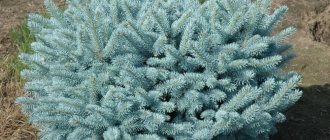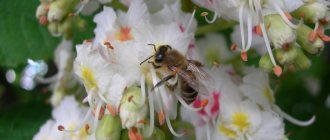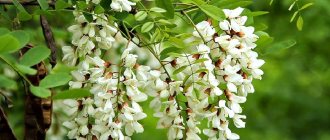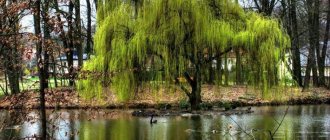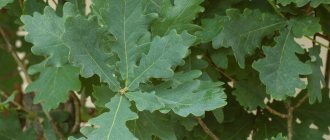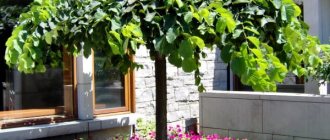A genus of evergreen monoecious trees, depending on the variety, capable of growing more than 80 m in height. It differs from cypress in having flatter branches and small cones that ripen in 1 year. Under each scale there are 1–2 seeds. The main types of cypress are Nootka, pea-bearing, Lawson, blunt-leaved, thuja-shaped, Leyland. Most representatives are characterized by frost resistance. Planting and care are similar for all types.
Nutkan
The international name in Latin is Chamaecyparis nootkatensis . Similar to Lawson's cypress; the main difference is the crown. At first it is narrow conical, later it becomes wide pyramid-shaped. The ascending shoots hang down at the ends. The bark is brownish-gray, cracks with age, and comes off in thin sheets. The needles are scale-like, sharp at the top. The species blooms in April. Female cones change color from brownish-red to brown with a bluish tinge and ripen the following year in May.
The ascending shoots hang down at the ends.
Varieties of Nootkan cypress:
- ‚Pendula‛;
- ‚Glauca‛;
- ‚Aypea‛;
- ‚Jubilee‛;
- ‚Lutea‛.
Chamaecyparis nootkatensis “Pendula” is a tree 10–15 m high with a straight trunk and weeping loose asymmetrical branches. At the age of 10 years it reaches 3 m, per year it increases by 15–25 cm. The Pendula cypress variety is undemanding to the soil, light-loving, and shade-tolerant. Requires abundant watering in summer and responds well to fertilizing with organic matter and complex mineral mixtures.
Glauca (Chamaecyparis nootkatensis "Glauca") is a tree 15–20 m high, reaching a maximum height of 40 m. The crown is neat, cone-shaped, expanding at the bottom to 5–7 m in diameter. The shoots are raised, the needles are hard, scaly, with a bluish tint. Glauka is undemanding about soil fertility, but prefers fairly moist areas. Young seedlings must be protected from wind and frost for the winter.
Landing
When is the best time to plant cypress? Planting can be carried out almost throughout the growing season, from spring to early autumn, but in such a way as to give the plants time to take root and prepare for wintering. It is best to plant cypress trees in the fall in frost-free and rainless weather. When planting in summer, young plants must be watered regularly.
The planting density of cypress trees should correspond to the growth vigor of the selected variety. Some vigorously growing trees can reach a height of 10-15 meters. Therefore, you should not plant them close to each other. Dwarf and slow-growing varieties require denser planting. For hedges, seedlings are planted at a distance of 50-60 cm.
Purchasing cypress seedlings in containers or bales gives the plant a better chance to take root and makes transportation easier. The pot will prevent the roots from drying out; such a seedling can be planted at any time of the year. It is better to buy seedlings with bare root systems in early spring or autumn. Before planting, place them in water and wait 10-30 minutes. This will stimulate the roots to grow.
The seedlings must be healthy; they must be inspected for diseases and pests. Saplings with browned needles will not be the best choice. Buying cheap seedlings that have signs of fungal diseases or the presence of pests is no less risky.
Planting cypress - step by step:
- Before removing the bush from the pot, we prepare the soil in which we plan to plant it. We remove all weeds with roots. If you only get rid of some of the weeds above the ground, they will easily grow back in a short time.
- To plant, dig a hole twice the size of the root ball. The bottom of the hole should be well loosened; a little compost can be added to the soil with which we will fill the hole to provide the plant with nutrients that will facilitate rooting. You can buy special soil for conifers with a low pH suitable for this type of plant.
- We take the seedlings out of the pots and loosen the root ball a little so that the roots grow better. When buying plants in a bale, you need to trim the tissue around the roots. Having placed the bushes in the holes, carefully fill them with substrate and compact the soil. This should be done well - it’s even better to stomp around the plants.
- Immediately after planting, the plants should be watered generously. It’s a good idea to make a small hole under the bush in advance so that water from rain or irrigation can concentrate around the bush and saturate the soil well.
- To increase the decorative effect, pine bark can be sprinkled under the plants as mulch, which will prevent excessive evaporation of water from the soil and the growth of weeds.
Pea-bearing
Chamaecyparis pisifera is a tree 25–30 m high, in rare cases reaching 50 m. The crown is cone-shaped or narrow pin-shaped. The branches grow horizontally, flat, hanging, densely covered with needles. The bark is smooth, coming off in thin stripes, red with a brown or bluish tint. The needles are adjacent, with spaced tops, dark green in color, have white spots and stripes below, and emit a distinct smell.
Male pea cones consist of 6–10 pairs of brownish pollen sacs. There are many female ones being formed. They are spherical in shape, up to 0.8 cm in diameter, brown with a dark or yellowish tint, and grow on short petioles. There are 8–12 soft seed scales, 1–2 winged seeds are formed under each.
The branches grow horizontally, flat, hanging, densely covered with needles.
Varieties of pea cypress:
- ‚Aurea‛;
- ‚Boulevard‛;
- ‚Filifera‛;
- ‚Plumosa‛;
- ‚Squarrosa‛.
Boulevard (Chamaecyparis pisifera "Boulevard" ) is used as an ornamental shrub or tree. The height is approximately 5 m. The crown is pin-shaped, symmetrical. The needles are awl-shaped, curved inward. The needles are silver-blue in summer, grayer in winter. At first the variety grows slowly, then growth accelerates. On average, the plant grows by 10 cm per year. Growing requires good lighting, fertile and moist soil. Winter hardiness for Boulevard cypress trees is quite low; protection from freezing is required.
Description of the plant
The genus Cypress (Chamaecyparis) belongs to the Cypress family. The natural distribution of the plants covers North America and East Asia, where they grow in humid climates with rainy summers.
Cypress trees are similar to cypress trees, but differ in flatter branches and smaller cones. They are also often confused with thuja, but the species are very easy to distinguish. Cypress trees have expressive, pointed scales that separate from the shoots. A white wax pattern is clearly visible on their underside. Plants can also be distinguished by their cones, which are more spherical in cypress trees than in thujas.
These coniferous plants are suitable for classic gardens of English, French or Italian styles. Plants are beautifully presented as a natural fence or hedge. Dwarf varieties are very elegant ground cover plants. Most varieties tolerate low temperatures well and rarely get sick. Plants are green and decorative all year round.
Botanical characteristics of cypress:
- Shape – trees or coniferous shrubs with a conical crown. The apical shoot is often drooping.
- The bark is thin, smooth, and often peels off in narrow strips.
- Shoots - the youngest ends of the shoots are fan-shaped in one plane and flattened.
- Leaves – young leaves are needle-shaped, mature leaves are scaly, growing crosswise in 4 rows.
- Fruits . Male cones (strobilae) are red (in the species Ch. Lawsonian and Ch. Obtus) or yellow, female cones are covered with a waxy coating, first greenish-violet, then woody, brown. Oval or spherical female strobili with a diameter of 4-14 mm mature 6-8 months after pollination. The cones fall off as soon as the seeds disperse.
Lawson
The international Latin name is Chamaecyparis lawsoniana . The species includes trees and tall shrubs and resembles a thuja in appearance. The maximum height of a mature plant is 81 m. The shape of the crown is conical, the top consists of small horizontally directed or pendulous shoots. The bark is made up of black-brown scales. The needles of the Lawson species are scale-like. Male inflorescences are purple-red, female inflorescences are greenish, growing at the ends of the shoots. The cones are round, green at first, open in September and release winged seeds, which differ from other types of conifers in the presence of resin glands.
The shape of the crown is conical, the apex consists of small horizontally directed or pendulous shoots.
On a note! Lawson's cypress is shade-tolerant at a young age and later requires good lighting. The species prefers to grow on light, moist soils.
Popular varieties:
- Blue Surprise (Chamaecyparis lawsoniana ‚Blue Surprise‛) characterized by a pronounced bluish tint at the tips of the shoots. The crown looks like a cone or column and thins out a little with age. The branches are directed vertically. The parameters of adult plants are 2–3.5x0.6–1.5 m, annual growth is 20–25x10 cm. The bark is cracked and reddish-brown.
- Lawson's cypress variety Globosa (Chamaecyparis lawsoniana ‚Globosa‛) - dwarf form with a rounded crown, up to 1.2 m high. The branches are drooping, beautifully extending to the sides. The needles are small, thin, shiny, greenish-blue in color. The variety is characterized by durability, light-loving, and low demands on growing conditions. Globosa tolerates shearing well and is smoke and gas resistant. In severe winters it can freeze slightly and does not tolerate dry soil.
- Ellwoodii (Chamaecyparis lawsoniana ‚Ellwoodii‛) - a cone-shaped cypress with a symmetrical loose crown. The annual growth is about 3–5 cm, over 10 years it grows to 1–1.5 m. The parameters of mature specimens are 3.5x1.2 m. This variety of the Lawson species is suitable for container growing. Frost resistance down to -17 °C, grows in sun and partial shade, does not tolerate dry soils. Elwoodies may suffer from spring sunburn.
- Lawson's cypress Columnaris (Chamaecyparis lawsoniana ‚Columnaris‛) is a slender tree up to 4 m high with a narrow columnar crown. The needles are scale-like, tightly pressed, dark blue in color, soft, and emit a characteristic odor. The species is suitable for pot growing, often decorates terraces, and is included in mobile compositions.
Soil requirements
Cypress trees prefer soil:
- humus;
- permeable;
- slightly sour;
- with moderate humidity.
Cypress blunt-leaved and Lawson's cypress have significant requirements for the choice of substrate; all species prefer rich, fertile soil.
You should not plant them in the soil:
- heavy;
- clayey;
- in places of stagnant water;
- Most varieties react poorly to high pH of the substrate, so when growing, the tree trunk circle should be mulched with bark.
If the substrate in the garden is churned, but not very alkaline, you can treat it for planting cypress trees. It is enough to dig deeply, loosen the soil and mix it with peat.
Blunt
Chamaecyparis obtuse is also known as hinoki or obtuse cypress. Tree-like form 25–50 m high, in cultivation it grows to 0.6–5 m. The crown is cone-shaped, composed of spaced branches. The bark is smooth, striped, and reddish-brown in color. The leaves are rounded, pressed, light green in color. Female cones of the blunt type are small and spherical.
The leaves are rounded, pressed, light green in color.
Varieties of blunt-leaved cypress:
- Nana Gracilis (Chamaecyparis obtusa ‚Nana Gracilis‛) - a dwarf shrub with a rounded crown, similar to a twisted shell. The height of the cypress is 0.5–0.8 m. The shoots are dense and grow horizontally. The needles are dense, dark green, shiny. Prefers fertile, moist soil and does not tolerate compaction. Grows best in partial shade. The variety is recommended to be cultivated in rocky and heather gardens, in small garden plots.
- Contorta cypress (Chamaecyparis obtusa ‚Contorta‛) - pin-shaped, up to 2 m high. The branches are spaced apart, short, curved. The shoots are thin, thread-like, covered with dense light green needles. To grow, it requires protection from the wind, fertile and moist soil, sun or partial shade. The variety is recommended for Japanese gardens and rock gardens.
- Teddy Bear (Chamaecyparis obtusa ‚Teddy Bear‛) - a slow-growing variety with an asymmetrical crown. Cypress shoots grow straight and look like ferns. The dimensions of an adult plant are about 1x1 m, the annual growth is 5x3 cm. The leaves are scaly, emerald in color. Undemanding to moisture and soil composition. Suitable for single and group plantings.
Choosing a landing site
Growing cypress trees is not difficult. They don't have big requirements. Places with high air humidity and mild winters are best suited for growing. Many cypress trees are sensitive to low temperatures and polluted dry air, so in regions with cold winters they are quite difficult to grow; frost-resistant species must be selected (for example, K. pea fruit).
Cypress trees prefer sunny locations, but most species do well in partial shade. They are not recommended to be planted in very shady places; in such areas they grow poorly and will quickly begin to thin out from below.
Lawson cypress, pea cypress and Nootkan cypress grow well in sunny parts of the site. Plants require an appropriate dose of sunlight, otherwise their shoots will be much thinner and less colored. All species do not like direct exposure to the sun in the southern part of the garden. Plants prefer sheltered, quiet locations with moderate sun exposure.
For growing in colder areas, you need to choose completely frost-resistant varieties. Tall varieties with a cone-shaped or columnar crown should be planted in areas protected from strong winds, which can damage the plants.
Dwarf cypress varieties are often planted in containers. When growing cypress in a pot, special attention should be paid to selecting a container of the right size (it should not be too small) so that the root system can grow freely.
Tuevidny
The international Latin name of the species is Chamaecyparis thyoides . Depending on the variety, it is represented by shrubs and trees; in cultivation it grows in height by 0.4–3.5 m, in container cultivation it is 1–1.5 m, in nature it reaches 20–35 m. The crown is often cone-shaped and narrow. The trunk is straight, up to 0.8 m in diameter, ¾ covered with thin, gradually expanding branches. The bark is ash-gray to brownish-red, smooth at first, later cracking and becoming unevenly furrowed.
The color of the foliage changes over the year from bluish-green to brownish.
Thuja cypress seedlings are covered with needle-like needles up to a year old; later they become scale-like, 0.2–0.4 cm long. The smell of the species is pleasant, reminiscent of cedar. The color of the foliage changes over the year from bluish-green to brownish. The cones are spherical, 0.4–0.9 cm in circumference, covered with 6–12 scales, covering 1–2 seeds. The fruits are initially green or purple and turn brown when ripe. They open in the second half of autumn, releasing 5–15 ripened seeds.
Varieties of thuja cypress:
- ‚Aurea‛;
- ‚Ericoides‛;
- ‚Hopkinton‛;
- ‚Ericoides‛;
- ‚Andelyensis‛;
- "Blue Sport";
- ‚Little Jamie‛;
- ‚Variegata‛.
Ericoides is a cypress tree with an openwork columnar crown. The variety differs from others in the color of its needles. Young needles are blue, old ones are grayish-green. In winter, purple and bronze shades appear. Plant parameters 1.5x2–2.5 m, grows very slowly. The branches have few branches, but are dense and directed in different directions. Coniferous wood is used for park alleys, alpine slides, and Japanese gardens.
On a note! Thuja cypress variety Top Point is used to create bonsai.
Growing and care
Growing cypress is not difficult, but you need to provide the plants with a suitable place for growth and development and proper care.
Watering
Cypress trees in the garden require regular watering in the first weeks after planting. Watering can only be done on frost-free days. We water systematically and thoroughly so that the water goes half a meter into the ground. It is not enough to simply water the top layer of soil, otherwise the water will not reach all the roots.
Later, shrubs require watering only during extreme heat and prolonged drought. Under normal conditions, mature plants do an excellent job of drawing water from the deep layers of the soil.
Cypress trees grown in containers must be watered regularly; their roots are much more likely to dry out. It is advisable to water every 2-3 days with a moderate amount of water. The substrate in the pot should be slightly moist, the top layer of soil should dry out slightly before watering again. Avoid overwatering and drying out the bushes. To water the cypress tree, it is better to use rain or settled tap water.
Fertilizer
Cypress trees do not have high nutrient requirements. They do not need to be fertilized regularly. It is enough to feed the cypress trees with compost twice a year (in spring and autumn).
Lawson's cypress, pea cypress and Nootkan cypress can sometimes exhibit nutrient deficiencies. Browning of the needles will be a visible sign of deficiency. In this case, it is worth feeding with multicomponent preparations.
For cypress trees grown in containers, it is worth purchasing a special fertilizer for coniferous species and applying it in accordance with the manufacturer's recommendations. There are many ready-made fertilizers for coniferous plants in stores; usually they only need to be diluted with water. Multicomponent formulations are often produced in the form of granules and are used once a season.
Trimming
You can trim cypress trees in early spring (March) or autumn, but not in frost. Trees growing in small groups or singly do not require shaping. Plants have an attractive appearance, which is their natural decoration. Therefore, most gardeners avoid pruning altogether. They form only plants growing in the form of hedges. Cypress trees respond well to pruning, but this does not affect the intensification of growth or flowering.
You can form dwarf varieties for bonsai trees. Cypress pruning should be fairly superficial and delicate. Avoid cutting deep into old wood as this will result in an unsightly appearance.
Most species (for example, pea fruit) tolerate regular formative pruning. Pruning cypress trees will not cause them to become too branchy.
In spring it is also good to clear old trees of dry, browned needles. Before harvesting, you can lay a film or cloth under the tree so that you can easily collect fallen old needles.
Diseases, pests
In heavy soils where water stagnates, cypress roots can rot.
The most common pest that affects cypress trees is aphids. Its presence causes discoloration and drying of the needles. Aphids more often attack young shoots in the spring; it is worth keeping this in mind when purchasing a seedling.
Cypress trees can be affected by the following diseases:
- Shoot dieback is a disease manifested by the browning and falling of needles.
- Late blight is a fungal disease that affects the entire root system. You can recognize it by the withering of the shoots and the browning of the needles. Non-intervention can lead to late blight affecting the entire plant.
- Gray rot is a disease that often affects cypress trees. A visible sign of its occurrence is a characteristic dusty coating on the needles and whole shoots. Gray mold requires spraying with fungicides.
Preparing for winter
In the autumn-winter period, cypress trees are in a state of “relative winter dormancy”, which is necessary to prepare the plant for the summer season. Different varieties have different frost resistance, but most cypress trees grow well in our climatic conditions.
Frost-resistant cypress varieties in the Moscow region and central Russia can survive the winter in a secluded, quiet place where there are no cold, gusty winds. To be safe, cypress trees can be covered for the winter with agrofibre or burlap to reduce the risk of branches freezing. Proper shelter is especially important in the first years of cultivation.
Cypress trees are not very demanding plants. With the right choice of variety, regular moisture, in a sunny, quiet place, they can grow for many years. With a little effort we can have a beautiful hedge, an intense green backdrop for other flowers, or the centerpiece of a garden or home.
Leyland
The variety Cupressos Leylandi was obtained by crossing large-fruited cypress and Nootkan cypress. The crown is cone-shaped or pyramid-shaped. The species is characterized by rapid growth; with proper care, per year the plant grows by 1 m at a young age, later by 0.4 m upward, 0.2 m to the sides. Mature representatives of the coniferous species have dimensions of 4–10x2–3 m. The needles are soft, scale-like, green in color with a bluish coating.
The species is characterized by rapid growth.
Cypress trees are widespread in landscape design due to their decorative crown. The crop requires care; many varieties are moisture-loving and die from drying out of the soil. External description and characteristics depend on the species and varietal affiliation of the genus.
How to propagate cypress by seeds
It is rational to propagate only natural varieties by seeds. The characteristic features of varietal forms during seed propagation are weakly repeated, and identifying them in the first years is very difficult due to the juvenile nature and unformed crown of the seedlings.
Seeds collected in autumn must be thoroughly dried at a temperature of +32…+43 ᵒС. It is better to store them in an airtight container at a temperature from 0 to +5 ° C, avoiding significant fluctuations and constant humidity, then they will not lose their germination for more than 15 years.
Cypress seeds have a resting “sleeping” embryo. To awaken the seed, cold stratification is necessary for 2-3 months. At the beginning of winter, to propagate cypress trees, seeds are sown in boxes or bowls filled with loose sandy loam soil and stored in a refrigerator or basement at an even temperature (+3...+5 ͦC) and moderate humidity of the substrate.
Stratified seeds are exposed to light in a warm (+18…+23ᵒ C) place, where they germinate. Seedlings are protected from direct sunlight and watered moderately. Excessively dense shoots dive.
When it gets warmer, normally developing crops are taken out into the garden and, after gradually getting used to the sun and fresh air, they are planted in a ridge for growing, avoiding windy and open sunny places. In the shade, young plants develop faster and winter better. Cypress trees tolerate transplants, even repeated ones, very easily.
Transfer
Since many Cypress representatives develop very quickly, they need to be replanted at least once every couple of years. Plants need to be planted in a spacious container, making sure to provide drainage (pebbles or expanded clay). Soil preparation is discussed above. After planting, if you prepared the mixture yourself, you should feed the plants.
Cypress planting


